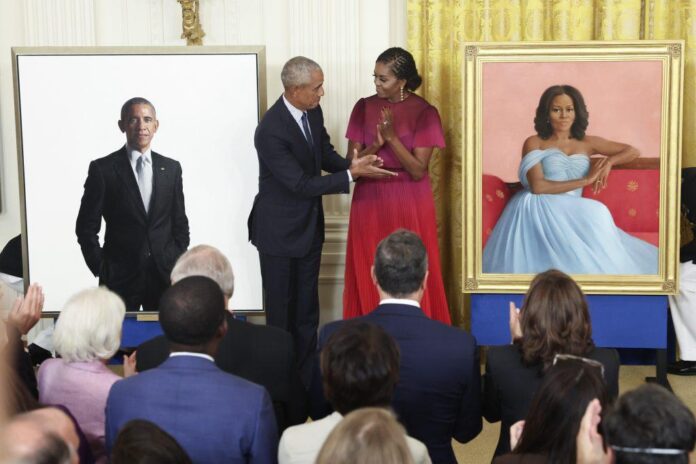More than five years after departing the White House, former President Barack Obama and First Lady Michelle Obama are back, if only for a few hours.
President Joe Biden and First Lady Dr. Jill Biden hosted the 44th commander-in-chief in the East Room on Wednesday for the unveiling of the Obamas’ official portraits. The paintings are a departure from the Obamas’ previously unveiled, and much celebrated, likenesses created for the National Portrait Gallery in 2018 by Kehinde Wiley and Amy Sherald. Commissioned by the White House Historical Society, these paintings—which will remain on view at the White House—take a more straightforward tack, but still manage to give the genre a modern twist.
The identities of the latest portrait painters were kept secret until today. Robert McCurdy, who is known for his photorealist portraits, painted Barack Obama; Sharing Sprung, who has been commissioned to paint other historic figures, rendered Michelle Obama. The Obamas made the selection themselves, as they did with Wiley and Sherald.
Today marked the first time in 10 years that an official portrait unveiling took place at the White House, since former president Donald Trump bucked tradition and declined to hold a ceremony feting his predecessor. The event also represented only the second time that the former president had ventured onto the grounds, and the first time the former first lady had returned, after the end of Obama’s second term in January 2017.
On stage, two easels draped in blue cloth were flanked by portraits of George and Martha Washington—”the father and the mother of the country,” as the Philip Kennicott put it during the newspaper’s livestream of the event. “This is about taking your place in the Pantheon.” The Obamas theatrically removed the cloths and revealed their portraits to applause.

This official portrait of President Barack Obama was painted by Robert McCurdy in 2018. Courtesy of the White House Historical Association.
McCurdy’s photorealist subjects, which typically present the person without props or adornment, have included Jane Goodall, Jeff Bezos, the Dalai Lama, Toni Morrison, and Muhammad Ali. Obama is depicted in a dark suit against a white background, staring straight ahead. The composition is starker than any of its predecessors, with no trappings of the office or signifiers of power or status in the background—just the former president holding the viewer’s gaze.
Sharon Sprung, a beloved longtime painting instructor at the Art Students League in New York, captured Michelle Obama. Sprung has a more painterly style than McCurdy, depicting her subjects with softer features, set against backdrops with visible paint strokes that are just as often abstracted swaths of color as actual places. Sprung’s previous subjects include the late Patsy Mink, the first woman of color and the first Asian American woman elected to Congress, as well as Jeannette Rankin, the first woman to hold federal office in the United States.
As in Sherald’s portrait, the former First Lady is depicted in a glamorous gown. “I want to thank Sharon Sprung for capturing everything I love about Michelle,” Barack Obama said in his remarks—including her poise, grace, and “the fact that she’s fine.”

Michelle Obama, painted by Sharon Sprung. Courtesy of the White House Historical Association.
“I felt this trust come from her, that you do your thing, I do my thing,” Spring said in a press release. “I’m going to trust you with your thing.”
McCurdy, meanwhile, noted that he gave Obama the same spiel he gives everyone who sits for him: “Look directly in the lens.
Don’t smile or gesture. And just hold into that moment. We’re looking for a more meditative or transcendent moment…[the President] did an excellent job of that.”
While the portraits painted by Kehinde Wiley and Amy Sherald belong to the Smithsonian’s National Portrait Gallery, the works today were commissioned by White House Historical Association. The association has funded the production of the official White House portraits since 1965.
Historically, the Portrait Gallery works tend to allow for more experimentation, while the official portraits are more traditional, figurative, and muted.
The most recent two presidents’ portraits traditionally hang in the Grand Foyer of the White House. In this case, former president Obama’s visage will hang alongside that of George W. Bush, replacing Bill Clinton, since there is no word on the arrival of an official portrait of former President Trump.

























